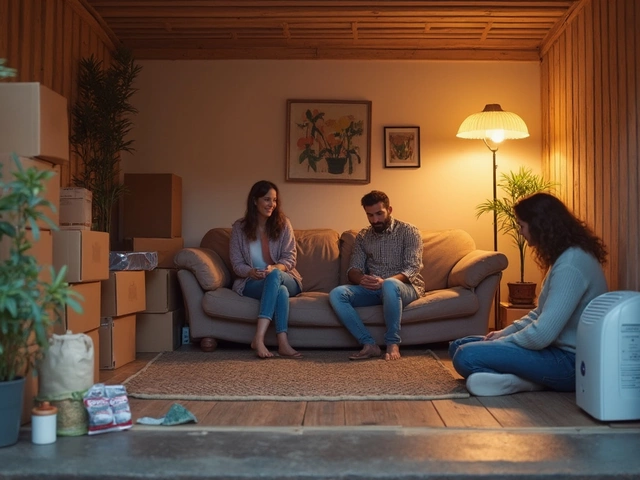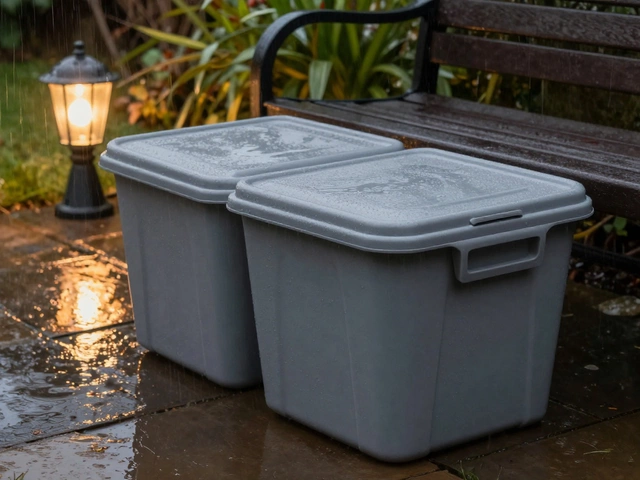Storage units offer a convenient solution for keeping personal belongings safe, but they come with their own set of challenges, primarily moisture control. Various factors contribute to dampness, from seasonal weather changes to the architecture of the storage facility itself.
To tackle these problems, products like DampRid have become popular choices. They promise to absorb excess moisture and keep your items dry, theoretically preventing mold and mildew. But how reliable are they in real-world scenarios? And are there other methods available to mitigate these moisture concerns effectively?
This article delves deep into these questions, providing practical advice and insightful analysis to help you maintain a dry and safe environment for your stored possessions.
- Understanding Moisture Issues in Storage Units
- How DampRid Works
- Tips for Effective Moisture Control
- Alternatives to DampRid
Understanding Moisture Issues in Storage Units
Storage units are incredibly useful for keeping belongings safe from clutter or during life transitions. However, they are not immune to moisture problems, which can result in significant damage to stored items. The primary culprit is humidity, which, when allowed to flourish unchecked, can lead to the growth of mold and mildew. This happens more frequently in regions with high humidity levels, but even in less humid areas, abrupt weather changes can cause moisture buildup. The construction material of the storage unit, such as concrete or metal, can also contribute to condensation, particularly during temperature fluctuations. Adding to this, inadequate ventilation can trap moisture inside, aggravating the situation.
When rain or snow is frequent, the risk of moisture ingress is heightened. Even a small amount of water seeping into a storage unit can become troublesome. It’s not just the rain; high ground water levels can also play a role. This is why selecting a storage unit with proper drainage systems and weatherproof seals is crucial. On the interior front, the way items are stored can make a difference. Placing items directly on concrete floors can lead to cooler surfaces, which are prone to condensation.
"To protect stored items from moisture, it's imperative to not only understand the external and internal environmental factors but also use preventive measures effectively," says Dr. Paul Stevenson, a renowned conservation specialist.
One interesting statistic from a recent report found that storage units without climate control systems reported moisture damage incidences nearly fifty percent higher than those with such systems in place, underscoring the value of temperature regulation. Moisture can quickly become a foe, causing not only unwanted odors and stains but, more pressing, compromising the structural integrity of cherished possessions, from vintage vinyl records to family heirlooms.
It is essential to grasp the implications of prolonged moisture exposure. Unlike short-term storage solutions where items might spend a mere few weeks or months boxed away, long-term storage requires vigilant moisture management. The goal is to maintain a climate that hovers around 55% relative humidity, minimizing risks. Intriguingly, a strategic combination of ventilation and moisture-absorbing materials, such as silica gel packs, can work wonders in lessening the moisture load without incurring significant costs or requiring structural changes.
| Moisture Source | Potential Impact |
|---|---|
| High Humidity | Mold Growth |
| Condensation | Rusting of Metal |
| Leaky Roof | Water Damage |
How DampRid Works
DampRid is quite a nifty product when it comes to battling moisture in small enclosed spaces, like storage units. At its core, DampRid uses calcium chloride crystals as the active ingredient, which is well-known for its ability to attract and trap moisture from the air. This natural compound is hygroscopic, meaning it actively absorbs water vapor from the surroundings and holds it, thus reducing humidity and creating a drier environment.
When you open a container of DampRid, the white crystals begin to absorb moisture immediately. The process starts with the attraction of water vapor, which is then transformed into liquid that collects in the bottom of the container. This crystallized agent continues to work until it completely dissolves, signifying it has maximized its water-holding capacity. What's crucial here is the consistent moisture removal, helping safeguard sensitive belongings prone to damp damage.
DampRid has been praised by many users. For instance, Mary Spencer, a customer with a prolonged history of using the product, shared in a review, "DampRid is the only product that’s worked consistently to keep my storage space dry. I've noticed zero mold growth since using it."The mechanical beauty of DampRid lies in its simplicity; it requires no electricity or batteries to function, making it an affordable and effortless choice for maintaining a dry storage unit.
Another appealing aspect is the variety of formats that DampRid offers. From hanging bag designs that are perfect for closets and wardrobes, to refillable tubs and even moisture-absorbing packets for smaller spots. Such options allow users to customize their approach based on the size and specific needs of their storage space. It's practical for both short-term and long-term storage conditions, which enhances its appeal among frequent and occasional users alike.
For those interested in metrics, a typical DampRid tub can absorb around 10-12 ounces of water depending on the ambient humidity and temperature. This capacity tends to be sufficient for spaces up to 1000 cubic feet. A strategic placement of multiple units can tackle larger areas effectively. However, keep in mind that the higher the humidity, the faster these crystals will dissolve, requiring more frequent replacements.
In essence, DampRid operates like a moisture magnet, pulling in excess humidity before it becomes a threat to your items. It's a silent, ongoing guardian against one of storage's most persistent perils. While it doesn't eliminate the need for other moisture control measures, such as proper ventilation or regular checks, it certainly adds a valuable layer of protection that can extend the life of belongings kept in storage. Whether vintage clothing, important documents, or cherished keepsakes, DampRid helps maintain their original condition, away from the clutches of damp damage.

Tips for Effective Moisture Control
Controlling moisture in storage units can be a bit of a task, but with the right strategies, you can safeguard your cherished belongings from the hazards of dampness. To start with, choosing the right location for your storage unit plays a crucial role. Opt for a unit that is elevated above ground level if possible, as this can prevent water seeping in during heavy rains. Soil absorbs water, and units closer to the ground might be more prone to dampness. It's not just the rain; humidity levels in a facility can dramatically affect the climate inside, so always choose storage units that advertise climate control. These are specially designed to maintain a steady environment, protecting your items from drastic changes in temperature and moisture.
Another vital tip is to use moisture absorbers like DampRid effectively. Place these containers in different corners of your storage unit to ensure they cover a broad range. Some units might require multiple absorbers depending on their size and the local climate. It's important to check these regularly and replace them when they become saturated. An intriguing fact here is that DampRid can absorb up to 10 times its weight in moisture, making it a powerful ally against dampness.
Don't overlook the arrangement of your items within the unit. Organizing your belongings off the floor can hugely impact moisture control. Utilize pallets or shelving units to elevate your boxes and furniture, allowing air circulation underneath. This simple step reduces the risk of mold and mildew forming on your prized possessions. Additionally, consider the types of boxes you use. While cardboard is common, plastic containers with tight-sealing lids offer better protection against moisture.~ For those in high-humidity areas, it may even be worth it to invest in vapor barrier bags for added security.
Regular check-ins on your storage unit are equally essential. Visiting every few weeks lets you inspect for any signs of moisture build-up or potential leaks before they escalate into bigger problems. This hands-on approach ensures that you can make timely interventions if needed. While visiting, you may also want to rotate the items, if possible, to ensure even wear and avoid potential damp spots becoming permanent issues.
According to the U.S. Environmental Protection Agency (EPA), "maintaining relative humidity between 30 and 50 percent can help prevent mold growth and reduce dust mites." This benchmark is not only useful at home but applies aptly to storage units as well.
Lastly, consider having a moisture barrier installed if your storage location supports such modifications. Plastic sheeting on the floor or walls can stop exterior moisture from filtering into the space, though always check the facility's regulations before making any alterations. Each of these steps contributes to forming an environment where your possessions can remain safe and pristine. It's about creating a holistic defense against potential moisture threats, using both products like DampRid and tactical arrangement of your items.
Alternatives to DampRid
While DampRid is a popular choice for controlling humidity in storage units, there are several other options that might suit your needs more effectively. Understanding these alternatives gives you a broader perspective on moisture management which is crucial when the protection of your cherished items is at stake. Products and techniques vary based on the level of humidity, the type of items stored, and specific conditions of the storage space. For instance, silica gel packs are a ubiquitous choice, especially given their effectiveness in small, enclosed spaces. They are commonly used because they are affordable, reusable, and non-toxic, making them ideal for delicate items like documents and electronics that may get damaged by moisture exposure. The packs work by absorbing and retaining moisture in a gel form. They’re easy to use, too—just scatter them throughout your boxes, and your items will be protected.
For larger spaces or extremely damp conditions, investing in an electric dehumidifier could be more effective. While it represents a higher upfront cost, an electric dehumidifier allows precise control over the humidity levels and works perpetually as long as there’s power supply. They efficiently remove moisture from the air and are ideal for those who need a robust solution. Of course, budget considerations are real for many of us. Making sure you choose a product that yields a balance between cost and effectiveness is critical for many households. An electric dehumidifier can rack up electricity bills, so it's key to monitor usage.
Sometimes, the simplest methods can be quite effective. Using charcoal briquettes is an age-old technique that can naturally absorb excess moisture. As quirky as it might sound, charcoal works effectively due to its porous nature. Placing this cost-effective solution at various points in the storage unit allows it to draw moisture from the air without introducing any chemicals. The downside here, though, is the need for frequent replacement to maintain effectiveness.
According to a study highlighted by the National Institute of Building Sciences, "activated carbon can adsorb pollutants and control humidity levels, endorsing its use in various settings to foster healthier indoor environments."
These alternatives give you a variety of ways to keep your precious belongings intact, protected from the ravages of time and climate. Whether you're caring for vintage clothing, sensitive electronic equipment, or delicate keepsakes, understanding and choosing the best method to manage environment-specific issues is empowering. Consider testing a combination of solutions to find the perfect synergy for your unique storage space. And keep an eye out for innovations like auto-regulating smart humidifiers that could redefine moisture control for hobbyists and collectors alike in the coming years.
| Solution | Cost | Effectiveness |
|---|---|---|
| Silica Gel Packs | $$ | High for small spaces |
| Electric Dehumidifiers | $$$$ | Very High |
| Charcoal Briquettes | $ | Moderate |





